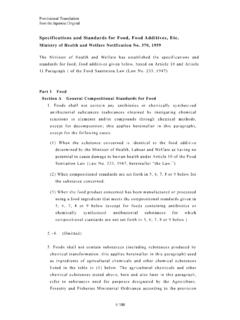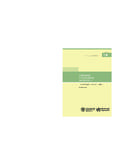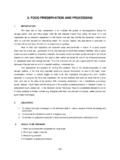Transcription of All Wales Catering and Nutrition Standards for Food and ...
1 All Wales Nutrition and Catering Standards for food and fluid Provision for hospital InpatientsOctober 2011 ISBN 978 0 7504 6806 0 Crown Copyright 2011WG13745 Contents page Preface 1. The need for Nutrition and Catering Standards for inpatients in hospital in Wales 1 Introduction 1 Scope of the Standards 2 Policy background 2 Overview of the Standards 4 Implementation and Monitoring 4 2 Recognising and meeting the nutritional needs of the hospital patient 5 Introduction
2 5 Nutritionally at risk hospital patients 6 Nutritionally well hospital patients 6 Delivering the Standards everyone s responsibility 7 All Wales hospital Nutrition Care Pathway Protocol 7 The role of healthcare professionals 7 Menu planning 9 Sustainability 11 3 Nutrient and food Based Standards for adults 12 Nutritional requirements of hospital patients 12 Rationale for differences in nutrient Standards set 13 Nutrient specification 14 Nutrient and food based Standards 16 food service Standards 17 Ward provisions 18 4 Practical guidance and menu planning for adults 19 Introduction 19 Achieving a combination and balance of foods from the five food groups 20 Provision of fluids 25
3 Meeting protein and energy Standards for the diverse hospital population 25 Soups and soup & sandwiches 29 Between meal snacks 30 food fortification 31 Healthier eating 33 Introduction 33 Practical Applications 33 Pregnancy / Lactation 34 5 Nutrient and food Based Standards for children 36 Introduction 36 Nutrient requirements for children 37 Achieving a combination and balance of foods from the five food group-menu planning guidance 38 Provision of fluids
4 41 Suitable snacks 41 Menu planning guidance for children 42 24 hour provision 42 Special considerations 42 6 Therapeutic Diet Provision 43 Introduction 43 Criteria 43 Menu coding 43 Kitchen space and equipment 44 Therapeutic diet overview and reference material 44 Healthier Eating diet 45 Allergen free diets 45 Gluten free diets 45 Texture-modified diets
5 46 Renal disease diets 46 Clean diet 46 Monoamine oxidase inhibitors diet 47 7 Special and Personal Diets 48 Tables Table 1 Minimum Nutrients for Menu Analysis 10 Table 2 Nutrient specifications for hospital menus for adults 14 Table 3 Nutrient and food based Standards 16 Table 4 Starchy carbohydrate foods 20 Table 5 Fruit and vegetables 21 Table 6 Meat, fish, eggs, beans and other non-dairy sources of protein 22 Table 7 Milk and dairy foods 23 Table 8 Foods containing fats.
6 Foods and drinks containing sugar 24 Table 9 Example energy and protein profile of a typical day for nutritionally well adult patient 27 Table 10 Example energy and protein profile of a typical day for nutritionally at risk patient 28 Table 11 Examples of soup + accompaniments as a main course alternative 29 Table 12 Foods which may be used to fortify dishes 31 Table 13 Menu planning for pregnant / lactating women 35 Table 14 Nutrient specification for hospital menus for children 37 Table 15 Menu planning for special and personal diets 50 Appendices Appendix 1 Nutritional analysis (energy and protein) for recipes used in Table 10 51 Appendix 2 Examples of snacks of specified nutritional value 52 Appendix 3 Proportion of nutrients children and young people should receive if they take breakfast and lunch at school 54 Appendix 4 Nutrient-based Standards for primary school children aged 5 11 years, for breakfast, lunch and after-school care 55 Appendix 5 Nutrient-based Standards for secondary school children aged 11 18 years, for breakfast and lunch 56 Appendix 6 Dietary reference values and derived amounts for nutrients per day.
7 Boys 57 Appendix 7 Dietary reference values and derived amounts for nutrients per day: Girls 58 Glossary of Terms 59 References 61 Acknowledgements 64 Preface hospital food is an essential part of inpatient care. Appetising food will encourage patients to eat well, and must contain the nutrients they need to recover from surgery or illness. Catering staff, dietitians, clinical staff, porters, nurses, speech and language therapists, healthcare support workers and other staff who contribute to the provision of food and fluid to hospital patients, all have an important role to play in the co-ordinated approach necessary to provide patients with a first class food service.
8 The Free to Lead, Free to Care report published in 2008 set out proposals which aimed to improve the patient s experience of hospital , including food provision and nutritional content. The Welsh Government, the Royal College of Nursing and Local Health Boards have been working in partnership to improve the patient experience of food provided in hospitals. The aim is to elevate the provision of food to the same importance as medication; raise awareness of Nutrition in relation to patient safety; and to enable Catering to be recognised as a clinical support service. The recent Wales Audit Office report hospital Catering and Patient Nutrition concludes that Catering arrangements and nutritional care provided to patients have generally improved since 2002, and patient satisfaction remains high, however, more still needs to be done to ensure recognised good practice is more widely implemented.
9 The introduction of the All Wales Nutrition and Catering Standards for food and fluid Provision for hospital Inpatients will support these ambitions. We would like to thank the Scottish Executive for allowing us to adopt the Scottish hospital Standards . We are grateful to those of you who have contributed to the development of the Standards , members of the Working Group and Steering Group and consultees. We now look forward to the successful implementation of the Standards . Tony Jewell Jean White Chief Medical Officer Chief Nursing Officer Chapter 1: The need for Nutrition and Catering Standards for inpatients in hospital in Wales Introduction The recognition of the scale and impact of malnutrition, particularly undernutrition, in the UK healthcare system gained national attention in the early 1990s.
10 Work on actions required to identify and treat malnutrition began in earnest and it became clear that the problem was on a Europe-wide scale. McWhirter and Pennington (BMJ 1994) quantified the incidence of malnutrition in hospitals. Public awareness was raised by the Kings Fund report, A Positive Approach to Nutrition as Treatment (1992) , and organisations such as Age Concern and Community Health Councils, which succeeded in putting this issue high on the political agenda through reports such as Hungry in hospital (1997) and more recently Still Hungry to Be Heard4. In 2007, the British Association of Parenteral and Enteral Nutrition (BAPEN) in conjunction with the Royal College of Nurses (RCN) and the British Dietetic Association (BDA) commenced the largest ever prospective national survey of the prevalence of malnutrition on admission to hospital and care in the UK5. In Wales , the risk of malnutrition in general acute hospitals in 2007 was over one in four adults (26%).







